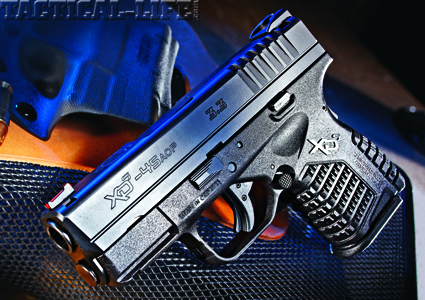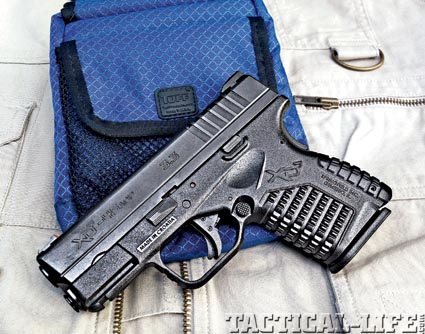The XDS offers it all to the concealed carry enthusiast—slim and petite dimensions combined with the big-bore stopping power of the .45 ACP cartridge.
Full disclosure here—I am a longtime fan of Springfield Armory handguns for concealed carry. In fact, one of my first carry guns was a Springfield Armory TRP .45 ACP 1911 (yes, all 42 ounces of it), with me later switching over to a full-size XD45 (the variant with the 1911-style manual safety). These were carried on my belt (in both cases with variants of the Milt Sparks Versa Max 2 inside-the-waistband holster), as both are very large guns. However, the one situation where I did not carry a Springfield was when I needed to employ pocket carry. Frankly, there was nothing in the company’s line in .45 ACP that I felt was suitable for this very specialized role.
As a result, I bounced around between all the usual suspects for pocket carry—small-framed revolvers chambered in .38 Special, ultra-compact pistols chambered in 9mm, etc. The truth was, I always carried the full-size guns whenever I could because I like .45 ACP as a defensive round. I simply had to make my peace with the fact that this round is hard to stuff into a pocket-sized pistols.
Advertisement — Continue Reading Below
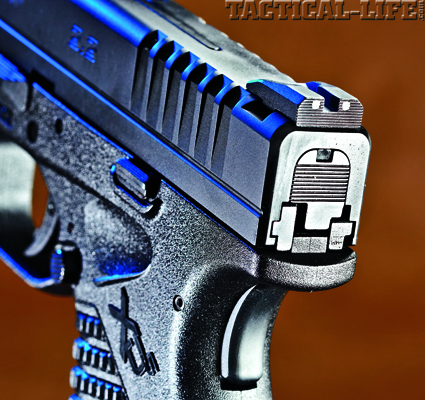
The rear sight features dual white dots. Unlike its bigger siblings, the XDS does not feature a striker status indicator at the rear of the slide.
Imagine my surprise when I walked up to the Springfield Armory booth at a 2012 industry trade show and saw a new addition to the XD line, one that is at once reassuringly familiar but also radically different from the rest of the series? That pistol is the new XDS, a “single-stack” variant of the enhanced XDM series of pistols. Chambered in .45 ACP and only 1-inch thick, the polymer-framed 5+1 pistol seemed to answer my interest in a truly powerful pocket pistol in a platform with which I am very familiar.
The key to the unique nature of the XDS is entirely summed up in the words “single-stack.” Prior to the development of this pistol, the entire XD line (the original XD and the new XDM variants) all were double-column pistols. This was true from the largest competition models such as the XDM 5.25 to the smallest compacts like the XD Sub-Compact. This characteristic is how the XDS achieves its slim 1-inch thickness.
Advertisement — Continue Reading Below
In discussing the pistol with Springfield Armory, they explained that they initially set out to develop a single-column 9mm XD “pocket pistol” with a width no greater than an inch, but quickly realized that they could make a .45 just as easily the same size. “As we worked on making a 9mm pistol this size, we soon realized that the high chamber pressures of the 9mm required a certain amount of wall thickness to the barrel. By stepping up to the .45 ACP with its much lower chamber pressure, we concluded that we could make the pistol in .45 ACP within the same size envelope.”
In one of those classic “Aha!” moments, the engineers at Springfield realized that they had the key to offering a pocket pistol variant of the XD that not only would get them into that segment of the market, but would also distinguish them from practically everything else available. “By offering a pistol in this size and chambered for the classic .45 ACP, we knew we had a winner,” they said.
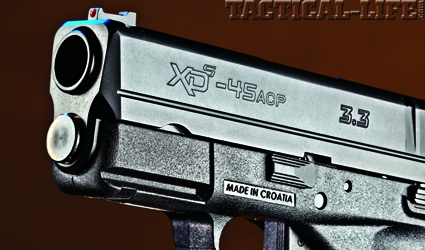
The 3.3-inch barreled .45 ACP pistol features a compact accessory rail on the dustcover portion of the polymer frame.
Advertisement — Continue Reading Below
Gun Details
The pistol that resulted is one that is simultaneously familiar and different, featuring recognizable characteristics of the XD and XDM pistols, but in a radically smaller package. In fact, the XDS’s 1-inch thickness makes it similar in size to many 9mm micro autos on the market. But, before we delve into the details of what makes the XDS different from the rest of the XD series, let’s cover what the micro pistol shares with its siblings.
For those familiar with the XD line, safety is a driving element of the design. The heart of this is the USA (Ultra Safety Assurance) trigger system, which employs a paddle “safety” located in the central face of the trigger. Unless engaged by the trigger finger placing rearward pressure on it, the USA system locks the trigger safely in place.
Advertisement — Continue Reading Below
In addition to this external safety mechanism, the XDS also employs an internal drop safety system, made up of a spring-loaded plunger that blocks forward movement of the striker unless the trigger is pulled fully to the rear. As the trigger is moved rearward, a raised projection on the internal trigger bar engages the drop safety and moves it clear of the striker to impact the chambered cartridge’s primer.
Also like the rest of the XD series, the XDS features a grip safety at the upper rear portion of the backstrap. Unless fully engaged by gripping the pistol firmly, the grip safety blocks the sear from pivoting down to release the striker. Working in concert with this is a large loaded chamber indicator on the top of the slide that provides both visual and tactile confirmation of the condition of the chamber. These, combined with the USA trigger system and the striker block safety, make for an extremely safe pistol.
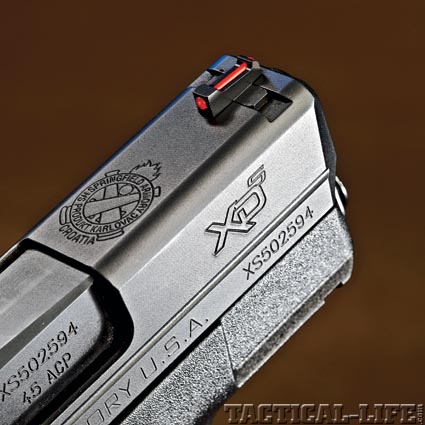
The light-gathering red fiber optic front sight of the Springfield offers a highly visible contrast to the dual white dots of the rear sight.
Advertisement — Continue Reading Below
The ergonomics of the pistol, although scaled down from its siblings, should also be quite familiar to fans of the XD pistol. The pronounced grip texturing of the XDM pistols has been carried over to the XDS, with six full lines of heavily patterned texturing that wraps around the front of the grip frame. The interchangeable backstrap has a matching textured section. The pistol comes with two backstraps—one “large” and one “small.” The magazine well of the pistol is beveled to enhance speed reloading of the 5-round stainless steel magazine. The XDS does not feature a magazine safety, meaning the pistol can be fired with the magazine removed. Also of note is the fact that the frame features a single-point strip of Picatinny rail on the dustcover, which is unique on such a compact auto. To ensure longevity, the polymer frame features steel inserts that have steel rails that interface with the slide.
The slide itself, made from carbon steel (although a stainless steel-slide “bi-tone” model is also offered), features “Sure Grip Slide Serrations,” located at the rear portion of the slide, which wrap up and slightly over the top of the slide. While on the subject of the slide, I should note the sighting system. Featuring a “snag-free” design, the three-dot sights are made up of two white dots on the rear unit (with horizontal serrations on the rear face to diffuse glare) and a fiber optic red front unit. The result is a high-visibility system that offers the three dots so popular these days, but also a front sight that stands out from the rear units for an enhanced “flash sight picture.” Further enhancing the “snag-free” qualities of the pistol are the angled edges of the face of the slide that should help in reholstering.
For those southpaws out there (myself included), it should be pointed out that the XDS is ambidextrous. In addition to the USA trigger system and the grip safety, the magazine release is fully ambidextrous with dual release buttons on both sides of the frame. They have subtle but effective thumbrest/recess channels located to the rear and above them on the polymer frame that guide the thumbs to them. The only non-ambi control is the slide release.
Advertisement — Continue Reading Below
Differences
Now, there are some areas where the XDS differs from the rest of the XD series, driven by the slimming of the design. First and foremost, the XDS features an external extractor. Measuring 1.25 inches long, the pivoting extractor is located on the right side of the slide to the rear of the cavernous ejection port. The claw of the extractor is quite large, measuring roughly 0.25 of an inch of gripping surface.
Another notable difference of the XDS from other XD pistols is the lack of a striker status indicator. On the rest of the series, the rear of the long striker extends out the back of the rear faceplate of the slide, giving a visual and tactile indicator of the striker’s status. However, on the XDS, the rear plate does not feature this, and is flat with no projections.
Advertisement — Continue Reading Below
The XDS pistol’s single-stack, 5-round magazine features a body constructed of stainless steel, has five numbered witness holes, a polymer baseplate and polymer follower. I noted that the follower has a steel insert on the ledge that engages the slide stop.
The resulting pistol is a very compact .45 ACP that measures a scant 6.30 inches in overall length, an inch in width and with an overall height of 4.40 inches (with magazine inserted). The barrel of the XDS measures 3.3 inches and features a fully supported ramp for enhanced feeding of self-defense loadings. The XDS is also quite light, weighing in at 21.5 ounces unloaded. The entire pistol features a deep black Melonite finish on its steel parts.
Advertisement — Continue Reading Below
Range Time
I received in Springfield’s prototype XDS pistol for reference and an early production pistol for testing and evaluation. I was once again struck by the pistols’ petite dimensions and light weight. Once I had inspected and lubed the production pistol, I took both out with a sampling of Hornady, Remington and Speer .45 ACP ammunition to put its through its paces.
Despite its size, the XDS proved to have surprisingly soft perceived recoil and was extremely accurate. However, about 200 rounds into the testing, I had an issue. I experienced some stoppages where the rounds would stick on the feed ramp. To see if it was a fluke, I tried out the prototype pistol. That pistol ran like a champ, but I had an issue with the extractor pin working its way loose, requiring me to push it down every 30 or so rounds.
A quick call to Springfield revealed that this issue was unique to my sample prototype and had been addressed in current production models through a redesign of the pin, as well as the feed ramp issue with the production gun. To verify these fixes, I asked that Springfield provide me with a follow-up production sample as soon as one was available. Soon thereafter, I had it in hand.
This pistol performed admirably, digesting all defensive ammunition I had on hand without a stoppage or an extractor issue. It also, like the earlier pistols, proved to be light recoiling and extremely accurate. Over the course of 300 rounds of ammunition, I did not have a single stoppage. I also tried it out in my pocket, with the pistol easily concealing in my front pocket and easily presenting for firing.
In addition to pocket carry, I also tried it out with a Tacllett Jr. from Tuff Products (tuffproducts.com). This discreet zippered case looks like a cell phone or camera bag and is designed to offer fast access to a handgun. The case features zippered sides and a Velcro top. You simply pull down, which opens the case in a split second, offering access to the pistol. Within the case is an elastic band that is designed to stabilize the pistol. It comes in two sizes—medium, for J-frame revolvers and the such; and small, for Ruger LCPs and the like. The XDS fit perfectly into the medium Tacllett, Jr. I was able to draw the XDS quickly and easily from the Tacllett Jr. All in all, this is a great alternative to pocket carry and traditional belt holster carry.
Final Notes
The XDS pistol proved to be an outstanding addition to the XD series of pistols. By jamming in the powerful .45 ACP round into a pocket-sized package, Springfield has managed to add an interesting alternative to the pocket pistol category. That, combined with the company’s reputation for quality and its lifetime warranty on its products, should make this one a real contender for those who want a compact pistol with full-size power. For more information, contact Springfield Armory, 800-680-6866, springfieldarmory.com.
